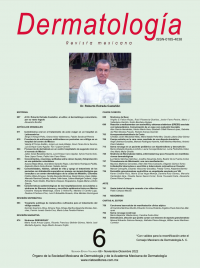Hyaline fibromatosis syndrome, a very infrequent disease with dermatological manifestations.
Dermatol Rev Mex. 2022; 66 (6): 720-726. https://doi.org/10.24245/dermatolrevmex.v66i6.8312
Luz María Sánchez-Sánchez,1 Josefina Navarrete-Solís,2 Beatriz De la Fuente-Cortez3
1 Pediatra, práctica privada Kids Doctor.
2 Dermatóloga, Hospital de Especialidades UMAE núm. 25. Monterrey, Nuevo León, México.
3 Genetista, Universidad Autónoma de Nuevo León, Monterrey, Nuevo León, México. Práctica privada Kids Doctor.
Resumen
ANTECEDENTES: El síndrome de fibromatosis hialina es una enfermedad genética muy poco frecuente que se caracteriza por lesiones nodulares-papulares en la piel y las articulaciones debido a depósitos hialinos. El diagnóstico se establece mediante hallazgos clínicos, biopsia de piel en la que se identifica la acumulación de material hialino y se confirma con el análisis molecular del gen ANTXR2.
CASO CLÍNICO: Paciente masculino de 3 años, hijo de padres jóvenes no consanguíneos del estado de Hidalgo, México, con lesiones papulares aperladas en la piel y las mucosas, así como nódulos en las articulaciones que limitaban su movilidad. Se confirmó el diagnóstico por biopsia de piel y mediante análisis molecular del gen ANTXR2 que reportó mutación c.1069del p.(Ala357Profs*52) homocigoto, patogénica del síndrome de fibromatosis hialina. El estudio de la familia no documentó consanguinidad; sin embargo, por ser homocigoto de una enfermedad sumamente rara es probable que sí haya algún nexo de consanguinidad.
CONCLUSIONES: Se comunica el caso de esta enfermedad genética rara que tiene manifestaciones cutáneas y articulares importantes, confirmando el diagnóstico por estudio del gen ANTXR2. En nuestro conocimiento, es el segundo caso reportado en México, pero el primero en el que se confirma la enfermedad por estudio molecular genético.
PALABRAS CLAVE: Síndrome de fibromatosis hialina; consanguinidad; mutación; biopsia.
Abstract
BACKGROUND: Hyaline fibromatosis syndrome is an ultra-rare genetic disorder characterized by nodular and papular lesions in skin and joints due to hyaline deposits. The diagnosis is done by clinical findings, skin biopsy with accumulation of hyaline material and confirmed by molecular analysis of the ANTXR2 gene.
CLINICAL CASE: A 3-year-old male patient, son of a young non-consanguineous couple from the state of Hidalgo, Mexico, with pearly papular lesions of the skin and mucosa, as well as nodules in joints limiting mobility. The diagnosis was confirmed by skin biopsy and molecular analysis of the ANTXR2 gene that reported a homozygous c.1069del p.(Ala357Profs*52) mutation, pathogenic of hyaline fibromatosis syndrome. The study of the family did not reveal consanguinity; however, it is a rare disease, the parents are from a small community, so it is likely that there is a consanguineous background of the parents.
CONCLUSIONS: We present a case of this rare genetic disease that has important skin and joint manifestations, confirming the diagnosis by mutation of the ANTXR2 gene. To our knowledge, this is the second case reported in Mexico but the first in which the disease was confirmed by molecular study where a pathogenic mutation of hyaline fibromatosis syndrome was identified.
KEYWORDS: Hyaline fibromatosis syndrome; Consanguinity; Mutation; Biopsy.
Recibido: noviembre 2021
Aceptado: enero 2022
Este artículo debe citarse como: Sánchez-Sánchez LM, Navarrete-Solís J, De la Fuente-Cortez B. Síndrome de fibromatosis hialina, enfermedad muy poco frecuente con manifestaciones dermatológicas. Dermatol Rev Mex 2022; 66 (6): 720-726.

